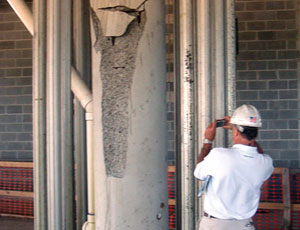The specific date in December for the implosion of the faulty, 376-ft-tall condominium tower on South Padre Island in Texas has not been set. But the demolition contractor says it has solved almost all the quandaries of one of its most challenging razings using explosives. If all goes according to plan, when the dust settles, Controlled Demolition Inc. (CDI) will have broken the height record, which it set in 1975, for imploding a reinforced-concrete tower.
The Ocean Tower job is one for the record books, and not just because it is 15 ft taller than the São Paulo, Brazil, tower that CDI previously took down. The preexisting structural damage means loads are not being transferred through the remaining structure in a “fully predictable, much less programmable fashion,” says J. Mark Loizeaux, president of Phoenix, Md.-based CDI. That means more caution during prep work.
CDI has never encountered such a heavily reinforced building. “We have never had to preblast openings in walls of a building we were going to implode,” says Loizeaux.
In broad strokes, the plan is to first straighten the tower, which has a slight tilt to the north, then tilt the tower to the east toward the Gulf of Mexico about 15 degrees and drop the tower vertically—all in about 12.5 seconds. But the devil is in the details, and CDI ranks the job as its second most difficult implosion, after Seattle’s Kingdome.
The tall, slender construction of the tower and its structural design and layout offer very few column lines and rotational reaction points to work with before all control over the structure is lost when it begins to fail vertically, says CDI. “The success of the implosion is, literally, going to turn on about 3.5 seconds of CDI’s delay sequence,” says Loizeaux. “After that, it’s in the hands of gravity.”
There also are complications related to the two-way, post-tensioned beam system at the base of the tower and in the parking garage. The many variables make Loizeaux “professionally concerned.”
The beachfront site isn’t helping. CDI has to design the collapse to avoid any impact on houses just 150 ft away, as well as nearby dunes, a road, other infrastructure and a park. The task would be easier if the tower were not founded on sand, which conducts vibrations.
“Everything looks like the vibration levels are well within safe limits for the adjacent buildings,” says David K. Miller, principal of Seismic Surveys Inc., Frederick, Md. The geotechnical consultant based its review on historic data from imploded tall buildings on beaches.
Debris remains a concern. To protect surroundings, workers are installing fencing, followed by geotextile screens, around columns, core walls and the periphery of the tower to floor 27. In front of the two nearest houses, CDI plans to build two- and three-story screens, covered with geotextile, each at least 100 ft long.
The development’s structural problems are attributed to differential settlement between its 33-story structural concrete tower and the three-level parking garage—200 ft x 238 ft in plan—on which the tower sits. Responsibility for the differential settlement, which reached 14 in. in places, is the subject of ongoing litigation.
The post-tensioning of up to 2,000 kips would have been challenging enough to accommodate in the implosion had the beam grid been complete. But there was a void left in garage slabs for the job’s tower crane, outside of the...





















